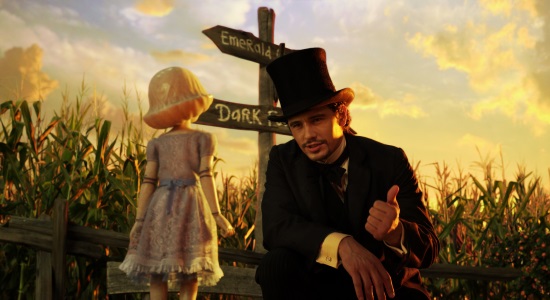
I don’t envy the filmmakers behind Disney’s Oz the Great and Powerful. It’s not that I consider expanding the universe of The Wizard of Oz (1939) a particularly challenging task. After all, L. Frank Baum’s original novel inspired fourteen sequels. It’s not either that the filmmakers were forbidden to use any of the iconic images created for Victor Fleming’s beloved adaptation. Who needs ruby slippers when you’ve got an emerald city, a yellow brick road, and winged monkeys with which to play?
Rather, my uneasiness stems from critics across the four corners of the Web now spewing nonsense about “the original” not drowning in digital effects and having more complex characters. We get it: you love “the original”, but do you realise that said original, which, by the way, was a remake, came out a decade before the first digital processor and that its cast of characters largely consisted of cuddly critters with a single personality trait, like the cowardly lion or the wicked witch? I can’t imagine what it must have been like for Sam Raimi and his crew to work so hard at entertaining a crowd that just wants to see them fail.
Oz (James Franco), on the other hand, knows a thing or two about it, what with his getting booed off stage because he can’t apply his magic tricks to making a paraplegic child (Joey King) walk. Oddly, the illusionist seems to shoulder that responsibility, so, when a tornado sweeps him off to the enchanted land of his dreams, we understand his eagerness to leave his failures behind and reinvent himself. Of course, our feelings might stem from Raimi matching the Kansas scenes to those of the 1939 classic, saving all the colour and anamorphic widescreen for the fantasy sequences.
Oddly, the same cannot be said of the 3D effects, which are applied evenly throughout Oz the Great and Powerful, presumably because the director couldn’t resist the image of our hero flinging his possessions over the black bands on the side of the screen. As one would expect from the creative mind behind The Evil Dead (1981) and Spider-Man (2002), Raimi fills every frame with a sense of wonder and exuberance, from the opening credits montage that suspiciously feels like a model for a new Disneyworld ride to the climactic battle between good and evil (it’s that kind of movie), which visually sets up crucial elements of Fleming’s The Wizard of Oz while still wrapping up every major plot thread.

I like how Oz’ adventure echoes both his past existence in Kansas and his future life as the man behind the curtain. Take, for example, the character of Finley, the winged bell monkey who serves as our hero’s disapproving sidekick. He’s voiced by Zach Braff, who also plays the failed magician’s long suffering assistant in the black-and-white bits. Joey King pulls double duty as well, popping up again midway into the film as a china doll who, you guessed it, lost the use of her legs. She steals every sequence she’s in with her morbid enthusiasm, making for a stark contrast with the witches’ wooden scenery chewing.
I’m generally a fan of both Mila Kunis and Rachel Weisz, and the screenplay by Mitchell Kapner and David Lindsay-Abaire makes good use of the Wicked Witch of the West, filling her backstory with tragic irony. However, her arc requires so many beats that one actress in particular ends up rushing from one extreme emotion to the next like a bipolar teen with a thyroid dysfunction. By the same token, Michelle Williams proves appropriately serene as Glinda the Good Witch, and I dig who she represents to both Oz and Dorothy in Kansas, but the role demands a certain blandness that plays against Raimi’s strengths as a filmmaker.
Fortunately, as its title indicates, Oz the Great and Powerful largely focuses on the future wizard, who, like Dorothy’s tin man, scarecrow, and cowardly lion, suffers from crippling self-esteem issues. Having convinced himself a worthless con artist, he lies and cheats his way to perceived greatness all the while sublimating his innate goodness. James Franco does a terrific job conveying a man estranged from himself (his performance is supposed to come off phony, people), and I admire the way Raimi ties the realisation that subterfuge can be a gift rather than a failure to the art of filmmaking. As I mentioned, I can’t imagine what it must have been like to work so hard at pleasing an audience that wants to see you fail. However, I suspect the challenge might have inspired much of this movie.






Recent Comments